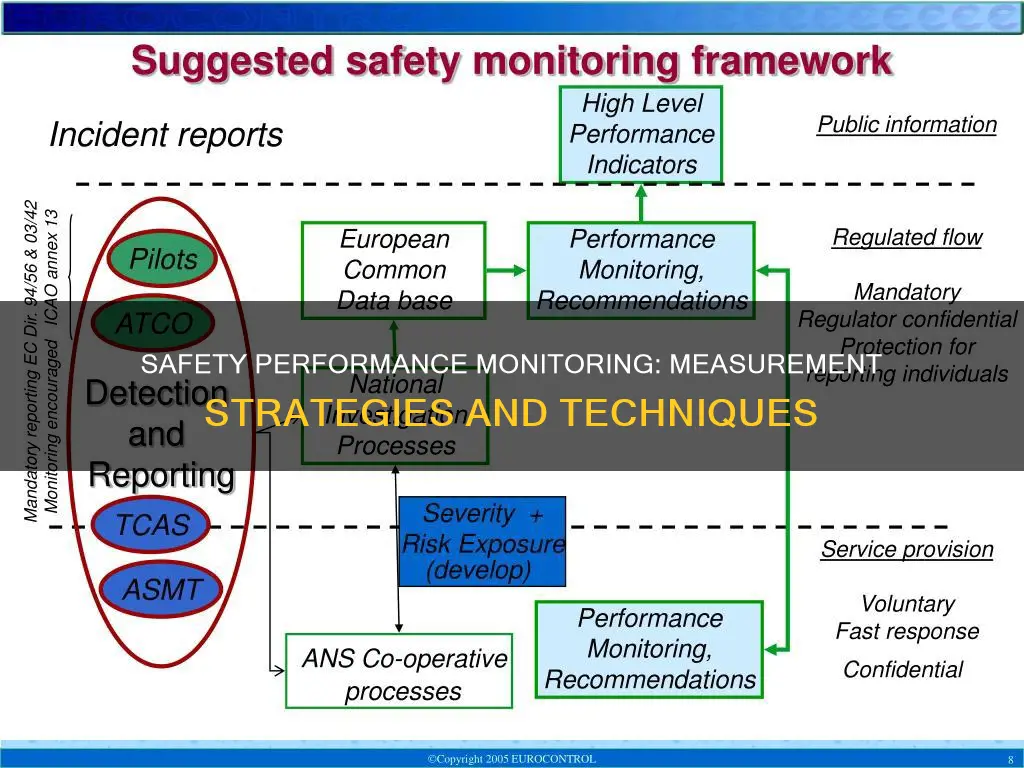
Safety performance monitoring and measurement is a critical component of any organisation's safety management system. It involves the ongoing collection of safety data metrics that indicate the health and progress of safety implementations and ensure that key safety goals are achieved. Safety performance monitoring and measurement is one of three elements that comprise the safety assurance component of the International Civil Aviation Organisation (ICAO) safety management system (SMS) framework. It is a means to verify the safety performance of an organisation and to validate the effectiveness of safety risk controls. Safety performance monitoring and measurement enable continuous monitoring and regular assessment of the safety levels achieved by an organisation during service delivery.
| Characteristics | Values |
|---|---|
| Definition | The means to verify the safety performance of an organisation and validate the effectiveness of safety risk controls |
| Purpose | To ensure that key safety goals are achieved |
| Scope | Operational, technical and organisational aspects |
| Data Sources | Mandatory incident reporting systems, voluntary incident reporting systems, safety audits, safety surveys, safety occurrence reporting, safety studies, safety reviews, systematic capture of data reflecting day-to-day performance |
| Indicators | Safety Performance Indicators (SPIs), leading indicators, lagging indicators |
| Measurement Units | Frequency of occurrences, e.g. number of events per year or per 1000 hours of operation |
| Reporting Frequency | Dependent on the nature and complexity of operations, level of risk and regulatory requirements |
| Actions | Identify trends, analyse causes, establish influencing factors, implement corrective actions |
What You'll Learn

Safety performance indicators (SPIs)
The International Civil Aviation Organisation (ICAO) safety management system (SMS) framework highlights the importance of SPIs in its safety assurance component. SPIs enable organisations to monitor safety performance continuously and conduct regular assessments to identify corrective actions and maintain acceptable safety levels.
The content of each SPI should include a clear description of what is being measured, its purpose, the units of measurement, data collection methods, responsible parties, and the frequency of reporting and analysis.
There are two types of SPIs: leading and lagging indicators. Leading indicators are proactive and focus on potential hazards or events that could contribute to negative outcomes. They provide insights into the current situation and help organisations improve their safety management systems. Lagging indicators, also known as outcome indicators, reflect negative outcomes such as the frequency of accidents or incidents.
When establishing SPIs, it is crucial to consider the organisation's data, industry best practices, and regulatory requirements. SPIs should be specific to the individual service provider and linked to predefined safety objectives. By utilising SPIs effectively, organisations can make informed decisions based on current and reliable safety data, ultimately improving their safety performance and creating a safer work environment for their employees.
Enabling Freesync on Your ASUS Monitor for Xbox
You may want to see also

Safety performance targets (SPTs)
SPTs are established based on an organisation's data, industry best practices, and regulatory requirements. They are designed to be clear and straightforward, avoiding complexity whenever possible. SPTs can be process-oriented, outcome-oriented, or related to specific interventions. For example, an SPT could be to minimise adverse safety events during ground operations by introducing additional safety measures.
SPTs are often accompanied by deadlines or time frames, such as achieving a certain number of reportable events per 10,000 operations within the next 12 months. They are an essential component of an organisation's safety management system, providing direction and focus for continuous improvement.
SPTs are also used to demonstrate the achievement of safety performance. For instance, an organisation might set an SPT to deliver safety management system training to a certain percentage of its workforce within a specified time frame. This target not only provides a measurable goal but also ensures that the organisation prioritises safety training for its employees.
In summary, SPTs are vital tools that help organisations strive towards a safer future. By setting clear and achievable targets, organisations can effectively monitor their progress, make data-driven decisions, and ultimately enhance their safety performance.
Syncing Your iPad: TV Monitor Connection Guide
You may want to see also

Proactive and reactive performance monitoring
Proactive performance monitoring involves monitoring data that indicates performance before a hazard occurs. It includes monitoring indicators such as the percentage of acceptable reported issues per month, the number of proactive issues reported per month, and the percentage of employees who have completed hazard identification training. Proactive safety measures can seem more expensive in the short term, as they involve spending time and money on health and safety before any issues have arisen. However, they can help enforce a positive safety culture, prevent accidents, and improve health and safety budgeting.
On the other hand, reactive performance monitoring assesses how well the SMS (employees and risk controls) can mitigate risky situations once a risk has occurred. Reactive safety measures include accident and incident investigations and ill health and sickness reviews. Reactive measures are taken after things have gone wrong, and there may be pressure to act quickly to resume work and reassure people that the issue won't recur. Reactive safety management tends to be more costly in the long term, as it involves dealing with the consequences of an accident or incident in addition to implementing corrective actions.
While proactive safety management is generally preferred, reactive safety management still has its place. Even in a proactive system, it is important to prepare for failures and put in place accident reporting and investigation procedures. The goal should be to improve proactive safety management to reduce the need for reactive measures.
Racial Incarceration Preferences: Freedom Within the Prison Walls
You may want to see also

Safety risk management
The first step in effective safety risk management is identifying hazards and potential risks within the organisation. This includes conducting regular safety assessments, analysing safety data, and encouraging a culture of reporting unsafe conditions and near-miss incidents. By proactively identifying risks, organisations can develop targeted mitigation strategies and prevent accidents and incidents before they occur.
Once the risks have been identified, the next step is to assess their potential impact and likelihood. This involves evaluating the severity of the potential outcome, as well as the probability of the risk occurring. Organisations can use tools such as risk matrices to help determine the level of risk and prioritise mitigation efforts accordingly.
The third step is to implement controls and measures to mitigate the identified risks. This may include implementing safety policies and procedures, providing training and education to employees, and making necessary changes to the work environment or processes. Organisations should also ensure that safety objectives and targets are established and communicated effectively to all stakeholders.
Finally, ongoing monitoring and evaluation are crucial to the success of safety risk management. Organisations should regularly review and audit their safety performance, analysing key performance indicators (KPIs) and safety performance indicators (SPIs) to track progress and identify areas for improvement. This continuous improvement process ensures that safety measures remain effective and relevant, and any new risks are identified and addressed promptly.
By adopting a comprehensive safety risk management approach, organisations can create a culture of safety and ensure that their operations meet established targets and industry best practices. Effective safety risk management not only protects employees and stakeholders but also enhances organisational efficiency, productivity, and overall success.
Monitoring SharePoint Performance: Strategies for Success
You may want to see also

Safety assurance
Safety performance monitoring and measurement is a key pillar of safety assurance, providing a means to assess the health and progress of an organization's SMS implementation. It involves the ongoing, real-time collection of safety data metrics that indicate how well safety processes and procedures are functioning. This includes checking risk levels, identifying hazards, evaluating safety policies, and conducting accident investigations. The data collected helps identify areas for improvement, track progress, and make informed decisions to enhance safety within the organization.
To effectively conduct safety performance monitoring and measurement, organizations should establish clear safety policies and objectives. Safety policies provide a framework for continuous improvement in safety levels, while well-defined objectives help set measurable targets. Additionally, a comprehensive understanding of hazards is essential, and both proactive and reactive approaches are necessary. Proactive hazard identification involves regular safety assessments and reporting schemes, while reactive approaches focus on collating information from incident reports and ensuring compliance with safety regulations.
Safety performance indicators (SPIs) and safety performance targets (SPTs) are crucial tools in safety performance monitoring and measurement. SPIs are metrics used to express the level of safety performance achieved and are typically expressed in terms of the frequency of harmful events. SPTs, on the other hand, represent the planned objectives for SPIs over a given period. Together, they provide a clear framework for assessing and improving safety performance.
By implementing effective safety assurance practices, organizations can enhance their safety culture, meet regulatory requirements, and ultimately protect their workforce. It empowers decision-makers with current and reliable safety data, enabling them to make informed choices that align with the organization's safety policy and objectives. Regular safety audits, surveys, and reviews are also integral to safety assurance, providing valuable insights and validating the effectiveness of safety measures.
Monitoring Children's Internet Usage: Parenting or Invasion?
You may want to see also
Frequently asked questions
Safety performance monitoring and measurement is a process that verifies an organisation's safety performance and validates the effectiveness of its safety risk controls. It is a critical component of safety management systems, helping to ensure that key safety goals are achieved.
Safety performance measures provide greater accountability, improved communication, and increased focus on safety priorities. They also facilitate better decision-making by providing relevant safety data and information to stakeholders and decision-makers.
SPIs are data-based parameters used to monitor and assess safety performance, while SPTs are the planned objectives for those indicators over a specific period. SPIs measure the frequency of safety events, while SPTs represent the desired outcome.
Examples of safety performance indicators include the number of incidents, near-misses, and accidents; the rate of fatalities and injuries; emergency response times; and public perceptions of safety.
Safety performance monitoring and measurement involves the ongoing collection and analysis of safety data metrics. It may include safety audits, inspections, surveys, occurrence reporting, safety studies, and reviews. This information is used to identify risks, assess safety policies, and make informed decisions to improve safety performance.







